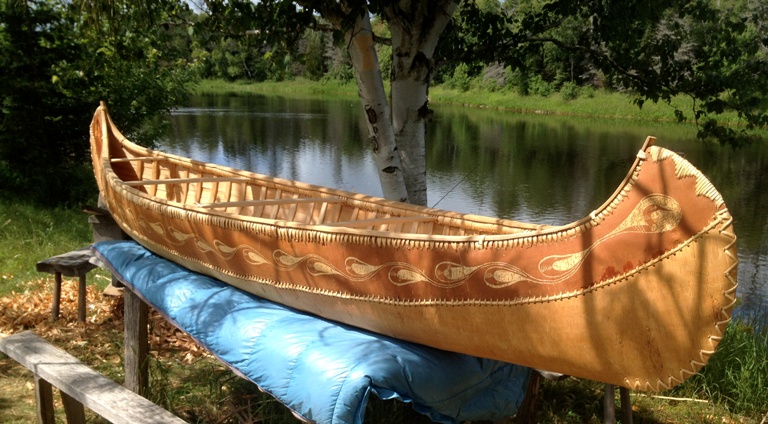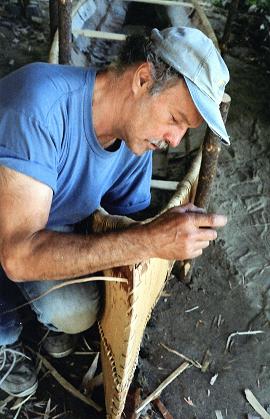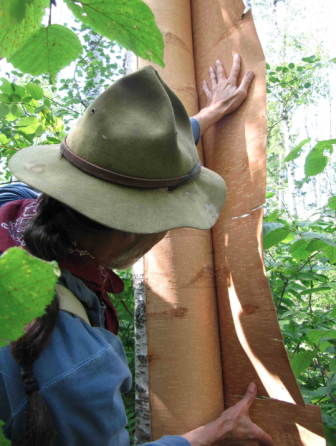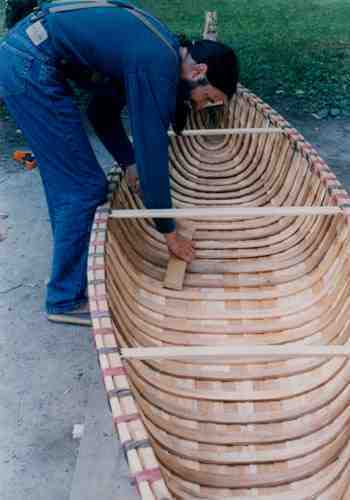
Tom Byers said he works best under pressure, adding decorations to his canoes last minute. Image: Courtesy Tom Byers
By Holly Drankhan
When Tom Byers of Whitefish, Ontario, first laid eyes on a birch bark canoe it was not what he saw that captivated him most.
It was what he heard.
“I hesitate to say the canoe spoke to me, but that’s what happened,” said Byers, who has built 74 of the vessels. “It was almost as if there was a spirit that was communicating telepathically with me from this birch bark canoe that I saw. It was really a powerful experience for me.”
Byers, a descendant of the Canadian aboriginal group Métis, is part of a movement to revive a craft once key to traveling the Great Lakes region.
The birch bark canoe was once a valuable means of transporting Native American goods, people and ideas, said John Low, an Ohio State University assistant professor of comparative and American Indian studies. It was adapted and used by Europeans during the fur trade.
During the past 30 years, Native Americans have worked to return a souvenir shop item to one of individual and community pride, Low wrote in an article published recently in the journal Material Culture.
The art of constructing birch bark canoes would be lost if not for the work of a

Tom Byers uses spruce root to lash together two sides of a birch bark canoe. Image: Courtesy Tom Byers
few dedicated people, Low said. Growing up in southwest Michigan as a member of the Pokagon Band of Potawatomi, Low remembers when elders in his community attempted to build a canoe, hoping others would follow in their footsteps.
One Native American working to keep the art alive is Ron Paquin, a self-taught artist and elder of the Sault Ste. Marie Tribe of Chippewa Indians in Sault Ste. Marie, Michigan.
Paquin’s mastery of birch bark canoe making earned him a 2003 Michigan Heritage Award from the Michigan State University Museum’s Michigan Traditional Arts Program. He was also awarded an Art Serve Michigan grant and a Native Arts and Cultures Foundation Artist Fellowship to teach the technique to tribal adults and youth.
“I am still learning and improving and believe that if I can’t learn from my students and apprentices, then I’d better stop making canoes,” Paquin wrote in a 2010 instructional booklet titled “Ron’s Honest Canoe.”
The booklet and accompanying video outline the birch bark canoe-building process step-by-step, providing pictures from a workshop with the Little River Band of Odawa Indians in Manistee, Michigan.

Eric Mase peels a sheet of bark from a birch tree. Image: Courtesy Eric Mase
First, large, thick sheets of white birch bark are unwrapped from tree trunks in the summer.
Paquin uses plywood sheets, rocks and stakes to shape the bark into the curved canoe bottom.
The bark is laced to the upper wood frame using spruce or jack pine roots. After the roots are dug from the ground, they are boiled, peeled and split to create strong, pliable ropes.
Rot-resistant white cedar is split to form the bottom planks and curved ribs of the canoe, which give the vessel its shape and stability.
Minor tears and seams between bark pieces are sealed with a mixture of pine sap and animal fat to make the vessel waterproof.
Although Paquin follows traditional building methods, he improves efficiency with some modern tools such as an electric drill and commercial caulking. He also purchases some of his lumber from mills.
Other self-taught craftsmen learn birch bark canoe building techniques from a variety of sources.
Eric Mase of Ely, Minnesota, learned the art from Edwin Tappan Adney, an early 20th century writer and artist. Adney documented Native American techniques for constructing more than 100 models in his 1964 book “The Bark Canoes and Skin Boats of North America,” which Mase refers to as “the Bible.”

Curved ribs made of white cedar are added the full length of the canoe to provide support and shape. Photo: Courtesy Eric Mase
“Each canoe has a different style, a different set of challenges, and the goal is to acquire the skills to meet those new challenges and try to see if you can make that certain canoe just the way it appears in the book,” Mase said.
Depending on the materials used, a 14-foot canoe can take between 30 and 50 hours to complete, Mase said. This time commitment requires dedication. Each artist has his or her own motivations for pursuing the art form in addition to income from sales.
Mase — who began building go-carts and tree houses as a child — enjoys the creative process.
“It’s like a musician,” he said. “You’re a novice and then once you reach a certain remedial level, you have a better understanding and you just keep refining and honing your skills and there is always something that you learn.”
“That’s what makes it worthwhile, I suppose.”
For Byers, the vessels are an example of what humans can accomplish when they work with nature rather than against it. They are made from renewable resources, do not create pollution when made or used and are completely biodegradable, he said.
“It has more to do with being connected to the earth and nature than it does a particular cultural tradition or religion of any kind,” Byers said. “It is about working with natural materials and making that connection.”
A number of individuals have joined Byers at his workshop to construct their own canoes. They include historical re-enactors, those hoping to become professional canoe builders and others who enjoy the canoe’s romanticism, Byers said.
“There are probably about as many reasons as there are people,” he said.
Whatever their motivations, artisans across the Great Lakes are working to sustain a work of art that is of cultural and historical significance to many in the area.
“The tradition of birch bark canoe building and travel is clearly not invented,” Low wrote in his article. “It has lived in the hearts and memories of native peoples throughout the Great Lakes, resting like seeds within the community – waiting to germinate and flourish.”
Check out Eric Mase’s work on his Facebook page and Tom Byer’s canoe collection on his website. Ron Paquin’s biography and artwork can be viewed on the Les Cheneaux Area Artisan Cooperative website.
Why were Native canoes sunk in rivers over the winter? Wouldn’t they be waterlogged by Spring time?
Thanks for this story. It’s great to see this craft preserved in the Great Lakes region. Those interested in the subject should look into John McPhee’s brief and fascinating book, “The Survival of the Bark Canoe.”